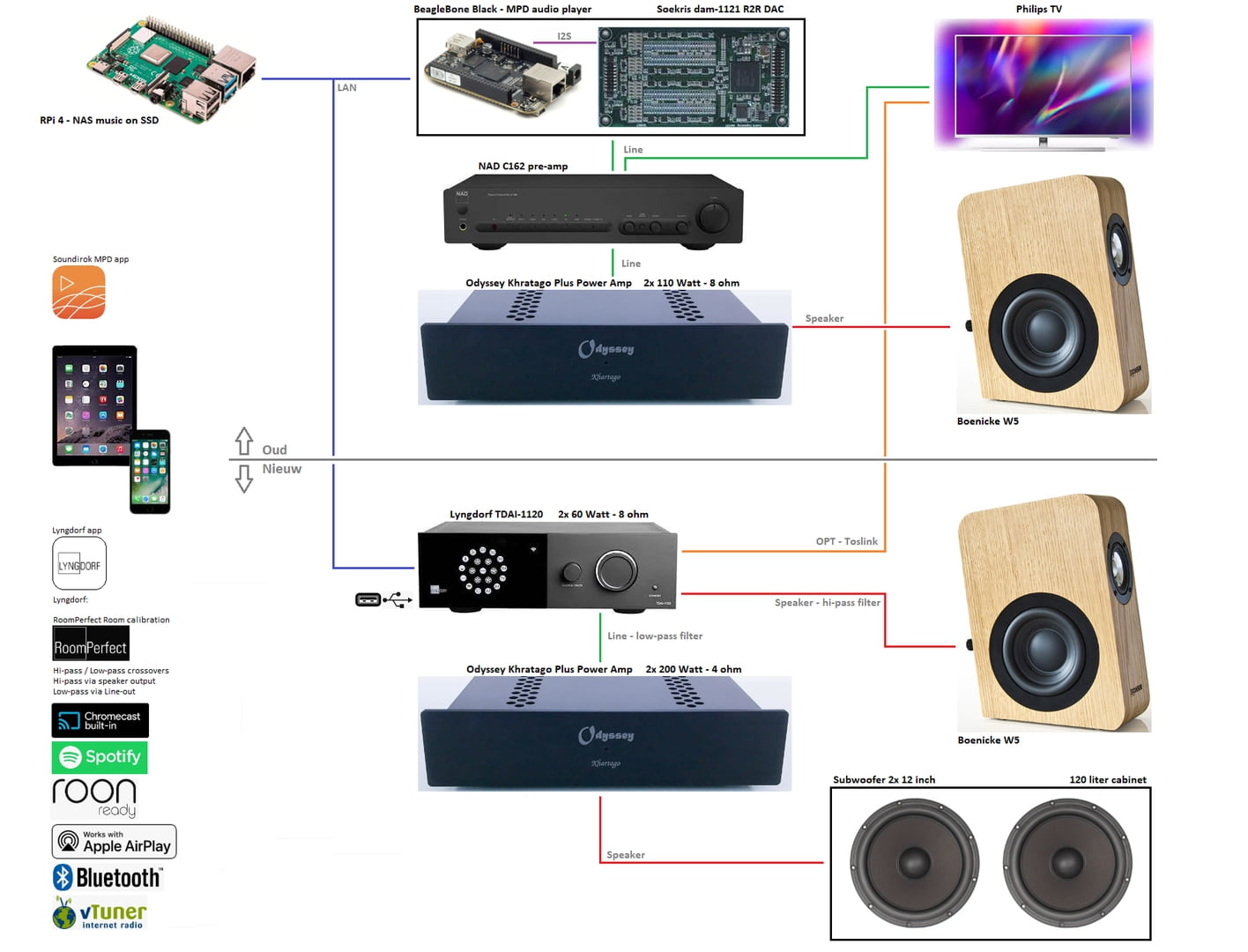I put all data in WinISD and the frequency rollof is less steep at 128 liter (2 subs) compared to 40 liters (2 subs)
The SPL curve in WinISD (with my amplification) has much more output than what my satellites can achieve.
Therefore shaving the top at the subs makes the "flat" frequency range towards the low end extend even further down.

The SPL curve in WinISD (with my amplification) has much more output than what my satellites can achieve.
Therefore shaving the top at the subs makes the "flat" frequency range towards the low end extend even further down.
@wiseoldtech - I'm going to bet you are hearing reflected sound from the back of the cone coming back out through the cone with a shallow box. It would tend to reflect higher frequencies. If the box is indeed sealed, then the pressure inside the box would limit rear cone movement and lower than atmospheric pressure (vacuum), when the cone moves forward, would limit forward movement.Regarding bass response and cabinet design....
I've found that when a woofer is in a shallow depth enclosure, and then mounted in a deeper enclosure, the deeper box allows the woofer to "reach down" and deliver far more bass into the room.
I figure that being in a shallow enclosure puts a limit on the woofer - the air inside behind the woofer is forced back against the rear of the cone, cancelling its travel to a point.
And this sort of thing happens regardless of whether it's a ported box or air-suspension/sealed.
Agreed, You will have some room to cut and some room to boost at lower frequencies.I put all data in WinISD and the frequency rollof is less steep at 128 liter (2 subs) compared to 40 liters (2 subs)
The SPL curve in WinISD (with my amplification) has much more output than what my satellites can achieve.
Therefore shaving the top at the subs makes the "flat" frequency range towards the low end extend even further down.
View attachment 1110129
When I was young, my parents had an expensive ($620 in 1964 dollars) stereo console in a unique style cabinet.@wiseoldtech - I'm going to bet you are hearing reflected sound from the back of the cone coming back out through the cone with a shallow box. It would tend to reflect higher frequencies. If the box is indeed sealed, then the pressure inside the box would limit rear cone movement and lower than atmospheric pressure (vacuum), when the cone moves forward, would limit forward movement.
It was an RCA Victor "hutch style" advertised as having "ear level" sound.
I often had to turn the bass control UP to the max to satisfy my enjoyment and got yelled at by pop for messing with the control.
Even then, it lacked the "punch" of my rock n roll albums.
The speakers were in the upper portion of the "hutch" - a 3-way system with a pair of 12" woofers with a common port. - I think the back panel was around 8" from the front.
The 1963 RCA Victor console I own now, is a compact lowboy (spinet) version, with the exact same "high end" electronics and amp (PP 6BQ5's- EL84's) as my parent's console.
And using the same woofers, it produced substantially more bass "punch", much deeper, I'd estimate 3 times the bass level.
Of course, I've completely restored and modified my console, along with the speakers to suit my taste, but these photos will show what I was talking about.... cabinet depth vs bass output.
One of them is a rear shot of the "hutch", the other is my "spinet' in early stage of modifications.
Nice to see such old srereo sets in a cabinet.
My young years were in the 70-80‘s were seprates became the norm and a stereo tower was owned proudly 😎
My young years were in the 70-80‘s were seprates became the norm and a stereo tower was owned proudly 😎
There are a number of things at work here, especially the low corner placement of the "new" cabinet. I have always wanted to rebuild an older cabinet. Both of those look AWESOME. With 3 times more bass, there is definitly something to your observation.
I noticed the older cabinet had a midrange and tweeter, does the "new" cabinet have a midrange and tweeter? This is just curiosity.
I noticed the older cabinet had a midrange and tweeter, does the "new" cabinet have a midrange and tweeter? This is just curiosity.
Yes, the new console has a 3-way speaker system.There are a number of things at work here, especially the low corner placement of the "new" cabinet. I have always wanted to rebuild an older cabinet. Both of those look AWESOME. With 3 times more bass, there is definitly something to your observation.
I noticed the older cabinet had a midrange and tweeter, does the "new" cabinet have a midrange and tweeter? This is just curiosity.
And the new woofers are long-throw high-compliant types with cloth roll suspensions with huge ceramic magnets.
The console puts out incredible low growly bass when called upon by the music.
And the added 3/4 inch wood lining and bracing of the cabinet kills any resonances well.
Plus, a 38dB sub-sonic (under 25Hz) filter eliminates any feedback at high volumes to the Garrard 3000 turntable.
I figure that being in a shallow enclosure puts a limit on the woofer.........And this sort of thing happens regardless of whether it's a ported box or air-suspension/sealed.
Falls in line with Altec's rule of thumb for not closer than 1.5x the driver's mounted depth and seems reasonable with a shallow and/or high Xmax woofer design it will be longer.
Cool, however my contributions were simply to show and explain some experience about cabinet depth and related woofer energy, as mentioned previously.Hi guys,
i also appreciate these old style cabinets with integrated stereo but if you really want to go the nostalgic route please start your own topic so I can keep track on the posts regarding my own subwoofer build 😉
I mentioned earlier that the depth is approx. 22-23 cm but now I did a real measurement and the actual depth is 23 cm + 2 cm for the panel were the woofer will be monted in so that makes 25 cm in total.Falls in line with Altec's rule of thumb for not closer than 1.5x the driver's mounted depth and seems reasonable with a shallow and/or high Xmax woofer design it will be longer.
The Dayton woofer has an installed depth of 146 - 9,6= 136,4 mm
250 / 136,4 = 1,83
I am not sure how the sloped angle of 12 degrees diverts the reflections even more but I will be out of the critical zone 😊
Good looking sub installation!I am not sure how the sloped angle of 12 degrees diverts the reflections even more but I will be out of the critical zone 😊
The angle won't "divert" low frequencies, but the cavity below the subs will provide upper "horn loading", raising output above around 80Hz.
Are you planning to use any DSP/EQ on the subs?
My comment referred to [and in retrospect, should have posted] a typical parallel baffle, side and/or back wall, though from theory/experience doesn't apply to > 12 deg included slopes or high aspect ratio cabs.I am not sure how the sloped angle of 12 degrees diverts the reflections even more but I will be out of the critical zone
Bass modules disguised & integrated into the room? What this is a pair of bass horns along two side-walls spanning the entire height, floor to ceiling, the length spanning the entire side of the walls. The driver sealed enclosure mounted up high, built into the rear corners. As expected, the room would have to be symmetrical.
==================================================================================Rick...

==================================================================================Rick...
Last edited by a moderator:
I bought a new amplifier for this situation, a Lyngdorf TDAI-1120 which is fully digital with dual output (speakers and line-out) which can be set with cross-over so I can connect the small speakers directly to the speaker output and the subs will be driven bij a power-amp connected to the line-out.
The cross-over is fully flexible with several BW or LR slope settings and on top of that there is their room measurement / correction system called RoomPerfect.
This should give me a good flat frequency response after calibration.
The cross-over is fully flexible with several BW or LR slope settings and on top of that there is their room measurement / correction system called RoomPerfect.
This should give me a good flat frequency response after calibration.
Looks good, and should sound great after dialing it in!This should give me a good flat frequency response after calibration.
The last 2 weekends I have been working on the woofer enclosure but unfortunate it did not go exactly as planned 🙁
The first weekend I had mounted the lower panel which had the holes for the woofer mounting.
To my surprise (I had never considered it) I could not slide the woofers under as they were too deep (high) to fit under 🙄

When I removed the panel again I forgot one screw which destroyed my panel so I had to make a new one.
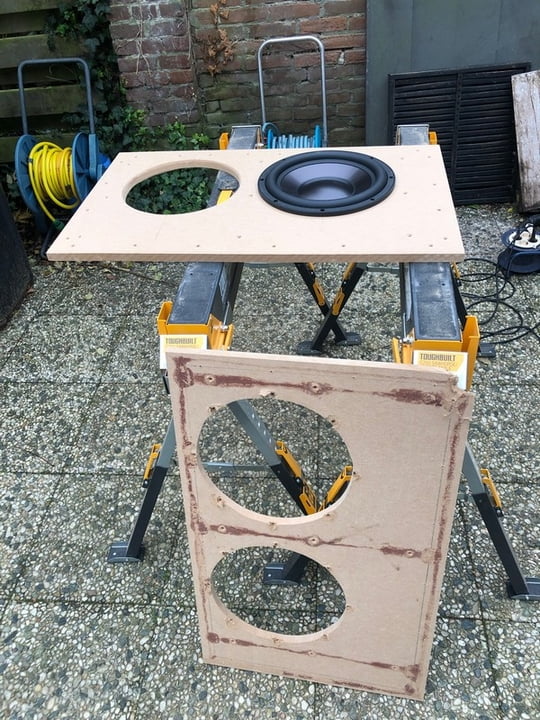

Sunday I had other plans so that weekend was completely wasted.
Last weekend I could finally continue again and hopefully everything would progress without ay problems.
As you can see the woofers are so big only few millimeters are left when sliding them under the frame.
Then I put the new panel over the woofers and slide them all together under the cabinet and install it that way.


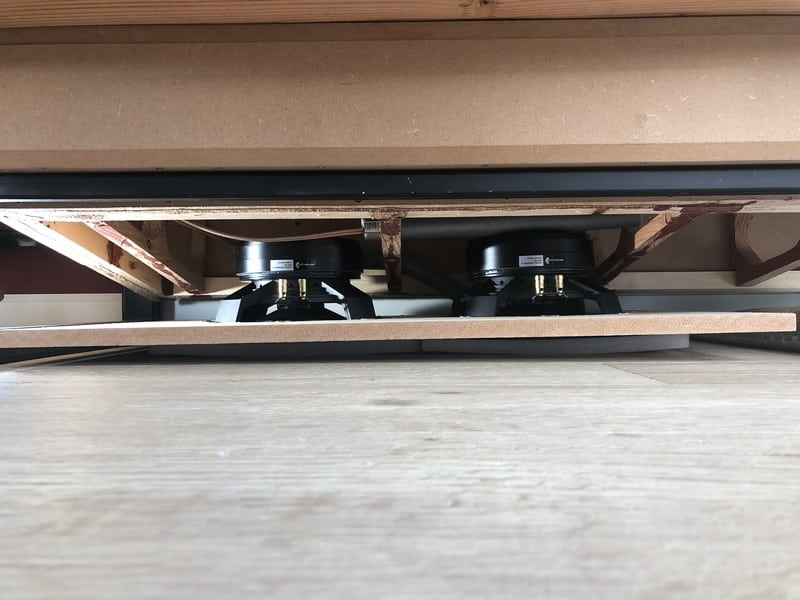
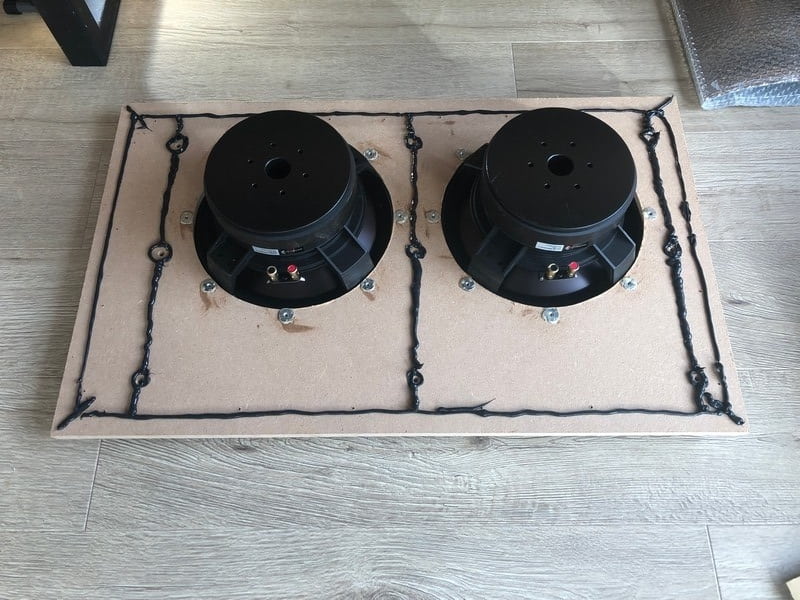

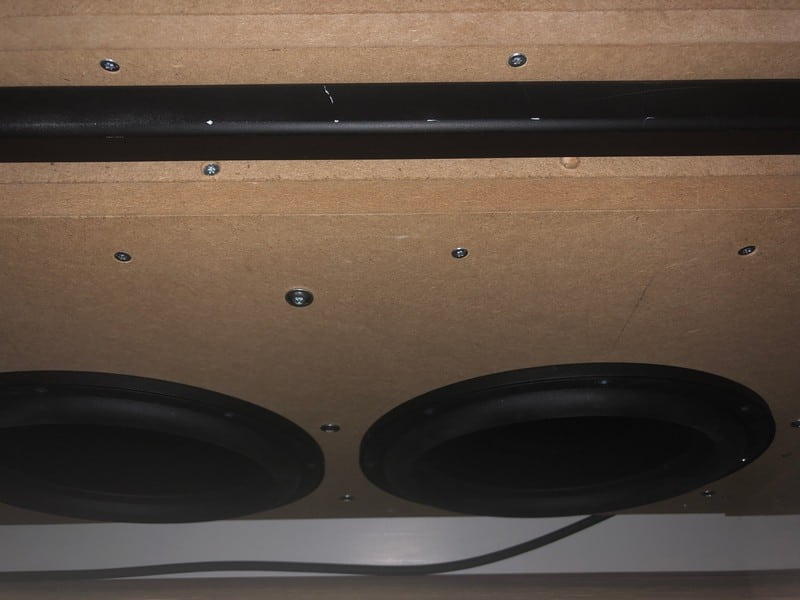
After finalizing the cabinet and connecting the equipment everything played well.
First I only had the subs playing as loud as possible (the big windows started to resonate at a certain (very high) sound pressure but the woofer cabinet and furniture / wood burner were dead-quiet.
As stable as a rock .. 😅
Yesterday evening I finally did the RoomPerfect calibration of the Lyngdorf and apparently the calibration needs to be done at a rather high volume, the menu advised to up the volume another 7 dB which I felt uncomfortable with thinking the neighbors would knock on my door and my cats were also getting nervous because of the strange loud sounds coming from the speakers 🙀
The menu also allows to do the calibration at the current volume setting so I did it like that.
The woofers really have plenty of power and because of the low distortion of the Lyngdorf amplifier it is very tempting to turn up the volume a little more but you can really feel the sound pressure but everything keeps nicely balanced.
The sound is really effortless and very nice.
I will do some more testing and also will have a XLR microphone / USB interface to measure the frequency response before and after calibration. I can also use the Lyngdorf microphone for that.
Unfortunate Lyngdorf does everything in the background so you so not see any curves or corrections applied.
The first weekend I had mounted the lower panel which had the holes for the woofer mounting.
To my surprise (I had never considered it) I could not slide the woofers under as they were too deep (high) to fit under 🙄

When I removed the panel again I forgot one screw which destroyed my panel so I had to make a new one.


Sunday I had other plans so that weekend was completely wasted.
Last weekend I could finally continue again and hopefully everything would progress without ay problems.
As you can see the woofers are so big only few millimeters are left when sliding them under the frame.
Then I put the new panel over the woofers and slide them all together under the cabinet and install it that way.






After finalizing the cabinet and connecting the equipment everything played well.
First I only had the subs playing as loud as possible (the big windows started to resonate at a certain (very high) sound pressure but the woofer cabinet and furniture / wood burner were dead-quiet.
As stable as a rock .. 😅
Yesterday evening I finally did the RoomPerfect calibration of the Lyngdorf and apparently the calibration needs to be done at a rather high volume, the menu advised to up the volume another 7 dB which I felt uncomfortable with thinking the neighbors would knock on my door and my cats were also getting nervous because of the strange loud sounds coming from the speakers 🙀
The menu also allows to do the calibration at the current volume setting so I did it like that.
The woofers really have plenty of power and because of the low distortion of the Lyngdorf amplifier it is very tempting to turn up the volume a little more but you can really feel the sound pressure but everything keeps nicely balanced.
The sound is really effortless and very nice.
I will do some more testing and also will have a XLR microphone / USB interface to measure the frequency response before and after calibration. I can also use the Lyngdorf microphone for that.
Unfortunate Lyngdorf does everything in the background so you so not see any curves or corrections applied.
- Home
- Loudspeakers
- Subwoofers
- Hidden subs (WAF requirement) design considerations
